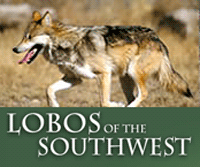The Arizona Republic (Original) Posted on July 24, 2014 by Brandon Loomis
Arizona's imperiled but rebounding wolf population is set to get a vastly increased range, but also perhaps a shorter leash around livestock and wildlife, under new rules proposed by federal wildlife officials.
The Mexican gray wolf — an endangered subspecies that lives only in Arizona, New Mexico, and with one new pack in Mexico — until now has been confined to a 4.4 million-acre forested mountain stronghold called the Blue Range. All releases of captive-bred wolves and transplants of roaming wolves have been confined to that zone straddling the Arizona-New Mexico line in the Apache and Gila national forests.
If the federal proposal is adopted after a 60-day comment period that starts today, wolves that behave themselves will be welcome anywhere south of Interstate 40. On paper, that's 98 million acres, though only about a fifth of that is considered suitable wolf habitat.
It's an expansion plan that state wildlife managers say goes too far and could hurt elk hunting in the mountains.
"It gives no upper limit to the number of wolves that can be there," said Jim deVos, the Arizona Game and Fish Department's assistant director for wildlife management. "Obviously, that's a concern to the state."
The state would prefer restricting wolves to a significantly smaller region east of State Route 87, which climbs the Mogollon Rim between Payson and Winslow, because elk herds west of there are more marginal, deVos said.
But wolf supporters say other provisions, such as loosened allowances for killing or capturing problematic wolves, will continue to threaten their recovery from near-extinction. Currently, animal owners are allowed to shoot wolves only if the animals are in the act of attacking their livestock on non-federal land. The new rule would also allow shootings when dogs were under attack.
The state also would gain the ability to kill or transplant wolves that make an "unacceptable" dent in any elk herd, a loosening of the existing prerequisite that a herd must first sustain a 35 percent reduction for two years. Federal officials say the state still will have to present scientific evidence that wolves are responsible for an "unacceptable" decline.
"The increase in acreage is huge and very significant," said Michael Robinson, a wolf advocate with the Center for Biological Diversity. But, he added, "for them to propose increased mortality is very worrisome."
Submit online comments by clicking on the "Comment Now!" feature for rule FWS–R2–ES–2013–0056 at http://www.regulations.gov.
Send written comments to: Public Comments Processing, Attn: FWS–R2–ES–2013–0056; Division of Policy and Directives Management; U.S. Fish and Wildlife Service; 4401 N. Fairfax Drive, MS 2042–PDM; Arlington, VA 22203.
Attend one of the following public hearings:
Aug. 11, 6-9 p.m., Hon-Dah Conference Center, 777 Highway 260, Pinetop.
Aug. 13, 6-9 p.m., Civic Center, 400 W. Fourth St., Truth or Consequences, N.M.
Each public hearing is preceded by an informational session from 2-4 p.m.





